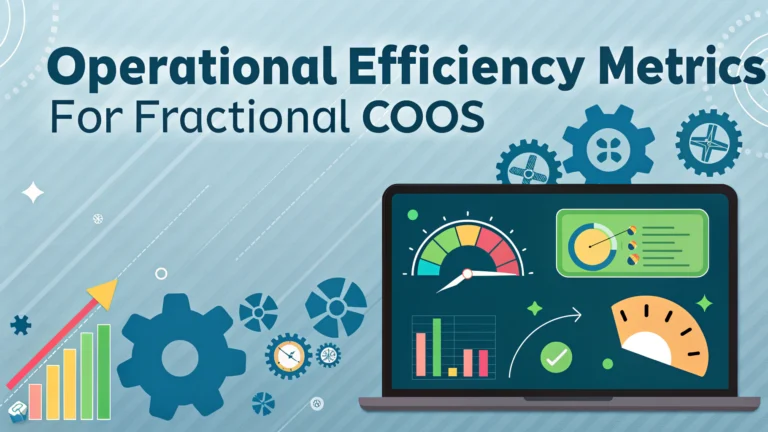Fractional COOs rely on clear metrics to demonstrate value and drive improvements across organizations they serve.
Measuring operational efficiency helps part-time executives identify opportunities, track progress, and communicate results to stakeholders.
This guide outlines the essential operational metrics fractional COOs should monitor to maximize their impact.
Core Financial Metrics
- Operating Margin: Revenue minus operating costs divided by revenue
- Cash Flow Metrics: Days sales outstanding (DSO), accounts payable turnover
- Cost per Unit: Total costs divided by units produced
- Revenue per Employee: Total revenue divided by number of full-time employees
Productivity & Process Metrics
- Project Completion Rate: Percentage of projects completed on time and within budget
- Employee Utilization Rate: Billable hours divided by total available hours
- Process Cycle Time: Time taken to complete key business processes
- Error Rates: Number of defects or mistakes per process cycle
Customer-Focused Metrics
- Customer Satisfaction Score (CSAT): Direct feedback from customers
- Net Promoter Score (NPS): Likelihood of customers recommending your service
- Customer Retention Rate: Percentage of customers retained over time
- Response Time: Average time to respond to customer inquiries
Team Performance Indicators
- Employee Turnover Rate: Percentage of employees leaving the organization
- Training Completion Rate: Percentage of required training completed
- Time to Fill Positions: Average days to fill open roles
- Employee Satisfaction Score: Regular feedback from team surveys
Technology & Systems Metrics
- System Uptime: Percentage of time systems are operational
- Software Adoption Rate: Percentage of employees actively using new tools
- IT Support Response Time: Average time to resolve technical issues
- Data Security Incidents: Number of security breaches or near-misses
Setting Up Your Metrics Dashboard
Select 5-7 key metrics that align with organizational goals and current challenges.
Establish baseline measurements before implementing changes.
Use visualization tools like Tableau or Power BI to create real-time dashboards.
Best Practices for Metric Tracking
- Review metrics weekly with key stakeholders
- Document measurement methodologies for consistency
- Set realistic targets based on industry benchmarks
- Adjust metrics as business needs evolve
Tools for Tracking Operational Metrics
| Tool | Best For | Key Features |
|---|---|---|
| Tableau | Data visualization | Custom dashboards, real-time updates |
| Asana | Project tracking | Task management, team collaboration |
| QuickBooks | Financial metrics | Financial reporting, expense tracking |
Moving Forward with Metrics
Regular review and adjustment of metrics ensures they remain relevant to business objectives.
Share success stories and improvements with stakeholders to demonstrate the value of metric-driven decision making.
Consider engaging with industry groups or professional networks to benchmark performance against similar organizations.
Implementing Metrics Successfully
Change management principles help ensure successful adoption of new metrics and reporting systems across the organization.
- Train team members on data collection methods
- Demonstrate how metrics connect to business success
- Reward teams for meeting measurement goals
- Create feedback loops for continuous improvement
Common Metrics Challenges
Data Quality Issues
- Inconsistent data entry methods
- Missing or incomplete information
- Manual tracking errors
- Multiple data sources
Implementation Hurdles
- Resistance to measurement
- Resource constraints
- Technical limitations
- Lack of standardization
Advanced Metric Analysis
Leverage advanced analytics to uncover deeper insights:
- Predictive modeling for forecasting trends
- Correlation analysis between metrics
- Machine learning for pattern recognition
- Automated anomaly detection
Driving Organizational Excellence Through Metrics
Successful metric implementation transforms organizational performance and creates sustainable competitive advantages.
Focus on continuous refinement of measurement systems and regular stakeholder communication to maintain momentum.
Remember that metrics are tools for improvement, not just performance evaluation. Use them to inspire positive change and innovation across the organization.
Maintain flexibility in metric selection and be prepared to evolve measurements as business conditions change.
FAQs
- What are the key performance indicators (KPIs) that fractional COOs typically track?
Revenue growth rate, operational costs, employee productivity, customer satisfaction scores, process cycle times, resource utilization rates, cash flow metrics, and project completion rates. - How do fractional COOs measure process efficiency?
Through metrics like process cycle time, error rates, throughput, bottleneck analysis, resource utilization, cost per unit, and automation rates. - What financial metrics are essential for fractional COOs to monitor?
Operating margins, cash conversion cycle, working capital efficiency, cost of goods sold (COGS), overhead expenses, revenue per employee, and return on investment (ROI) for operational initiatives. - How frequently should operational metrics be reviewed by a fractional COO?
Key metrics should be monitored weekly or monthly, with comprehensive quarterly reviews and annual strategic assessments. - What workforce productivity metrics do fractional COOs focus on?
Employee turnover rate, revenue per employee, absenteeism rates, training effectiveness, overtime hours, task completion rates, and employee satisfaction scores. - How do fractional COOs measure customer-facing operational efficiency?
Through customer response times, first-contact resolution rates, service level agreement (SLA) compliance, customer satisfaction scores, and customer churn rates. - What supply chain metrics are important for fractional COOs?
Inventory turnover, supplier delivery performance, order accuracy, warehouse efficiency, transportation costs, and supply chain cycle time. - How do fractional COOs assess technology and systems efficiency?
System uptime, software utilization rates, IT incident response times, digital transformation ROI, automation success rates, and technical debt metrics. - What quality control metrics should fractional COOs monitor?
Defect rates, quality compliance scores, customer complaint rates, product return rates, and quality audit results. - How do fractional COOs measure project management efficiency?
Project completion rates, budget variance, milestone achievement rates, resource allocation efficiency, and project ROI.







